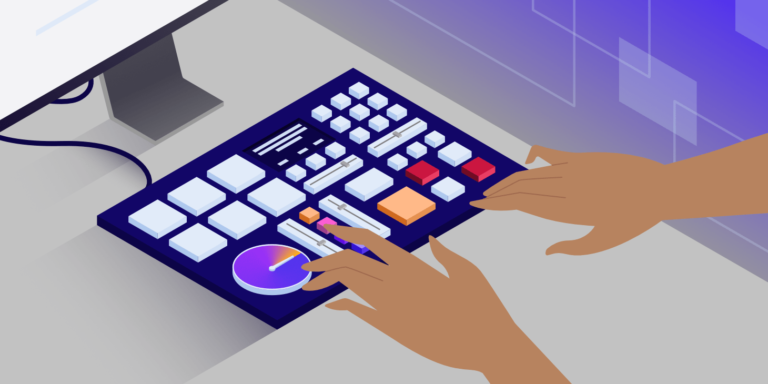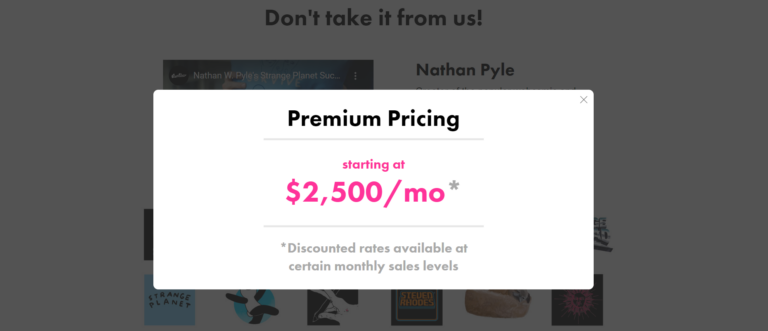Dec 23, 2024
Margarita L.
Redmine is a free, open-source project management tool that helps teams track their work and meet deadlines. You can use it to assign tasks, resolve issues, plan sprints, and customize each feature to your needs.
Want to learn more about Redmine and whether it’s the right choice for your team? We’ll walk you through its key features and show how they can fit into your workflows.
Redmine overview
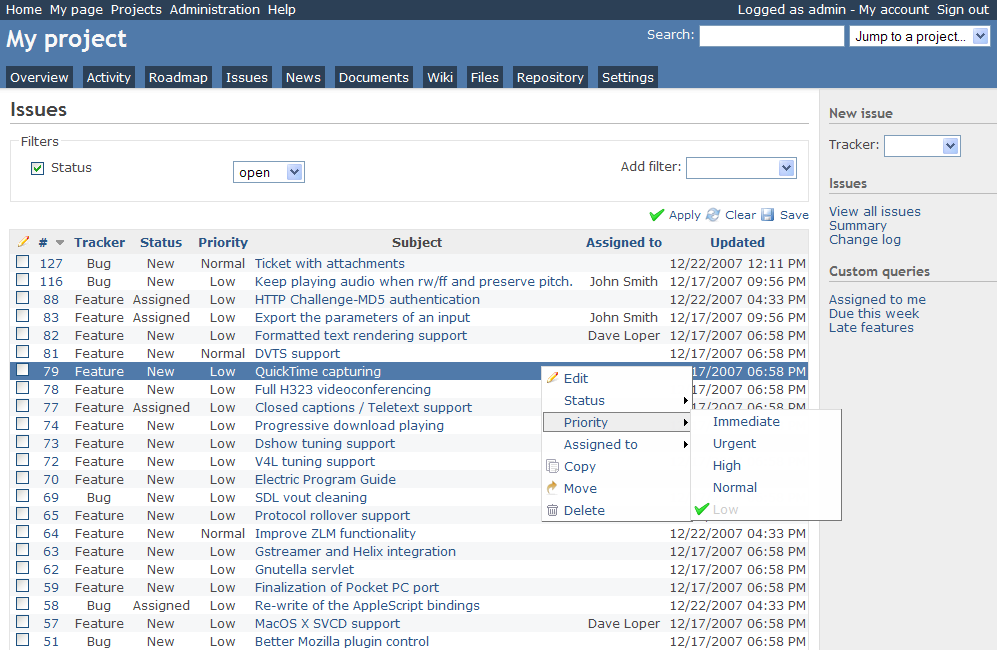
While many project management tools lock you into a specific system, Redmine lets you organize work your own way.
You can customize pretty much everything, from issue tracking fields to workflow permissions and user roles.
This flexibility comes from Redmine’s open-source nature. Built on Ruby on Rails, it can be modified to fit different needs.
You can start by choosing which features you want in each project – wikis for documentation, time tracking for billing, or issue boards for task management. As your projects become more complex, you can enable more features or install plugins.
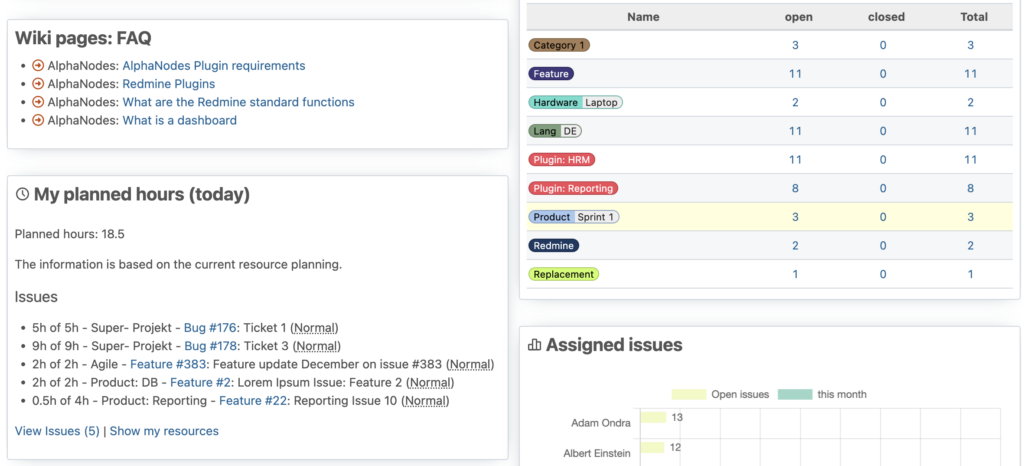
While Redmine was originally created to manage software projects, its adaptable features can benefit other teams. For example, it can be a great fit for marketing and design teams, as well as client-facing projects.
Key features of Redmine
Let’s explore Redmine’s foundational features, from project management to collaboration tools and customizable reports.
Project management
Redmine keeps all your projects in one place and makes it easier to organize complex work. For example, large projects can be broken down into smaller subprojects, helping teams manage different aspects of their work.
Some use subprojects to separate the phases of their project, while others create them for specific clients or departments.
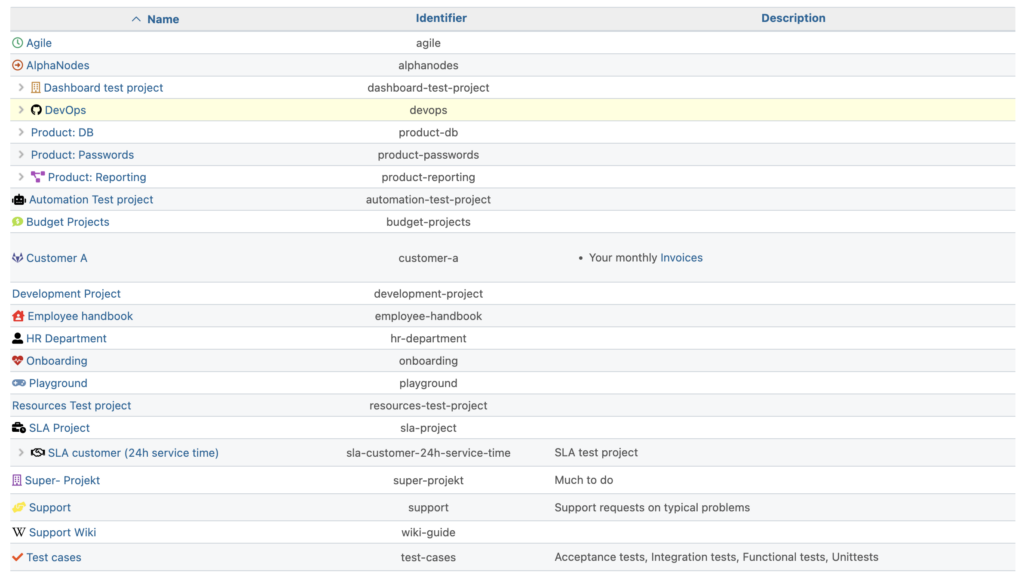
When it comes to planning work visually, Redmine’s Gantt charts show your timeline with task dependencies and upcoming deadlines, all color-coded by status. The calendar view complements this by organizing milestones into daily, weekly, or monthly views.
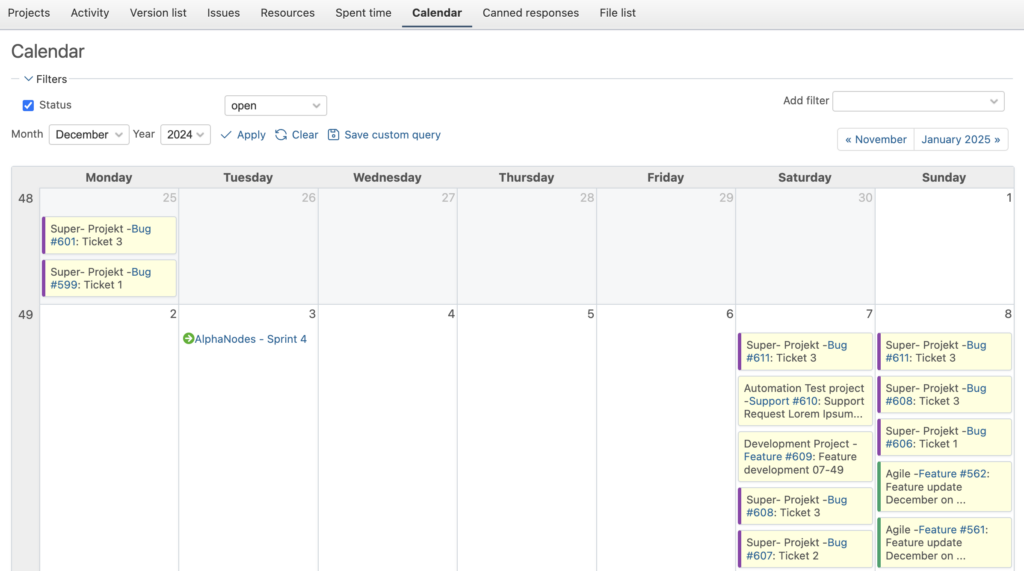
Issue tracking and ticketing system
With Redmine, each task, bug report, and feature request becomes a trackable issue that team members can follow until completion.
Here’s what you can do when managing issues using Redmine:
- Create issues through email
- Add custom fields for specific information
- Set priority levels and due dates
- Assign work to team members
- Attach files and add their descriptions
- Link related issues together
- Set up watchers who will receive update notifications
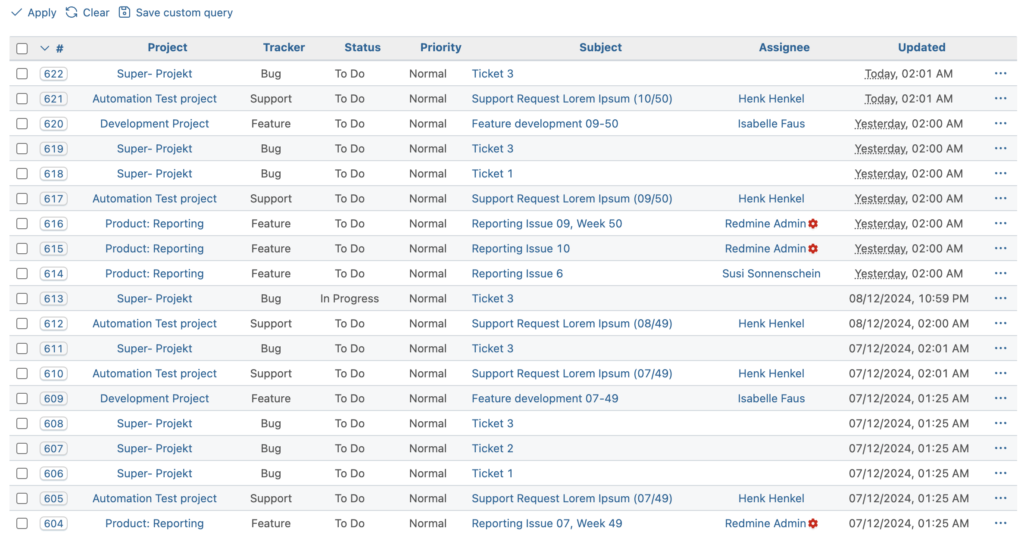
Redmine comes with three predefined issue types: Bug, Feature, and Support. Since teams often need more options, administrators can create additional types to match their specific needs.
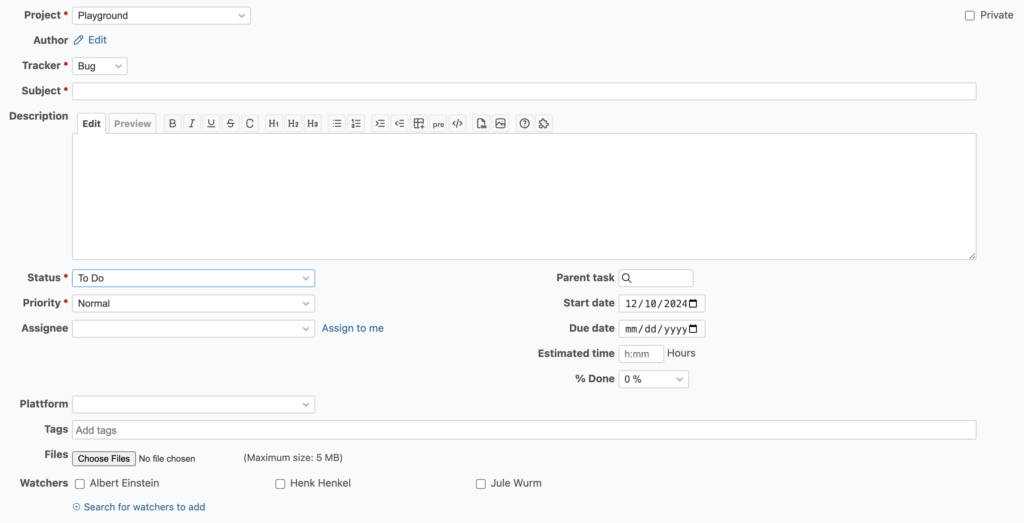
Project managers get a central dashboard where they can view all issues at once. They can track progress through project roadmaps and quickly find what they need using the built-in search and filtering.
Time tracking and resource management
Redmine also helps you track the time spent on different types of work. Users can log their hours on individual tasks, project versions, or entire projects. These time logs give you a clear picture of the team’s current workload and the project’s progress.
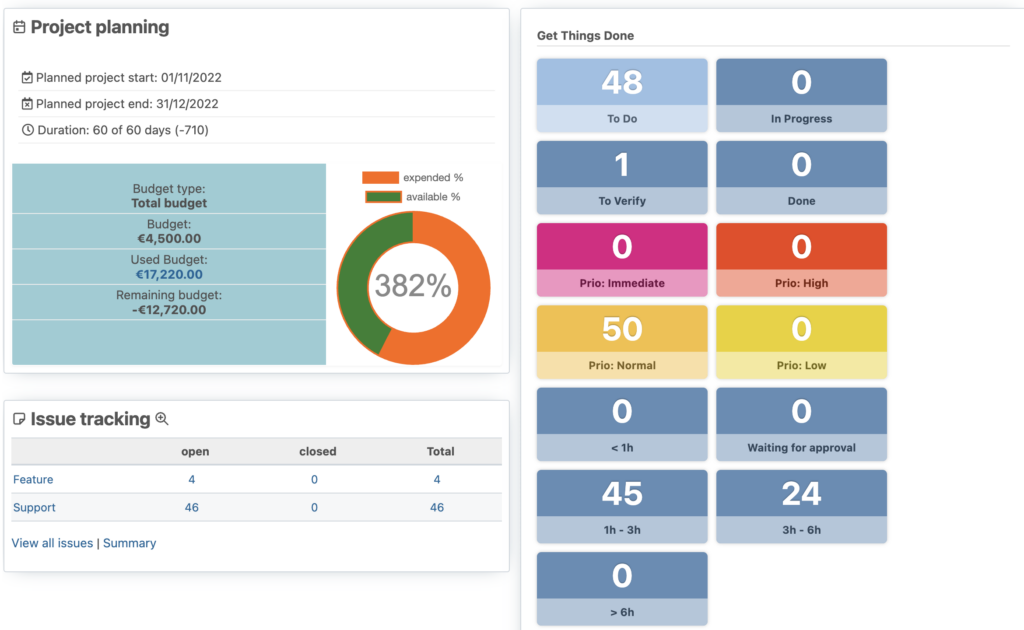
When logging time, you can:
- Record hours in decimal or hours:minutes format
- Add notes about completed work
- Categorize time by activity type
- Log multiple time entries at once
- Track estimated vs actual hours spent
- See completion percentage based on logged time
The time reports break down hours by person and project. They can let team members know whether their work is progressing as planned and help project managers understand how resources are being used across different tasks.
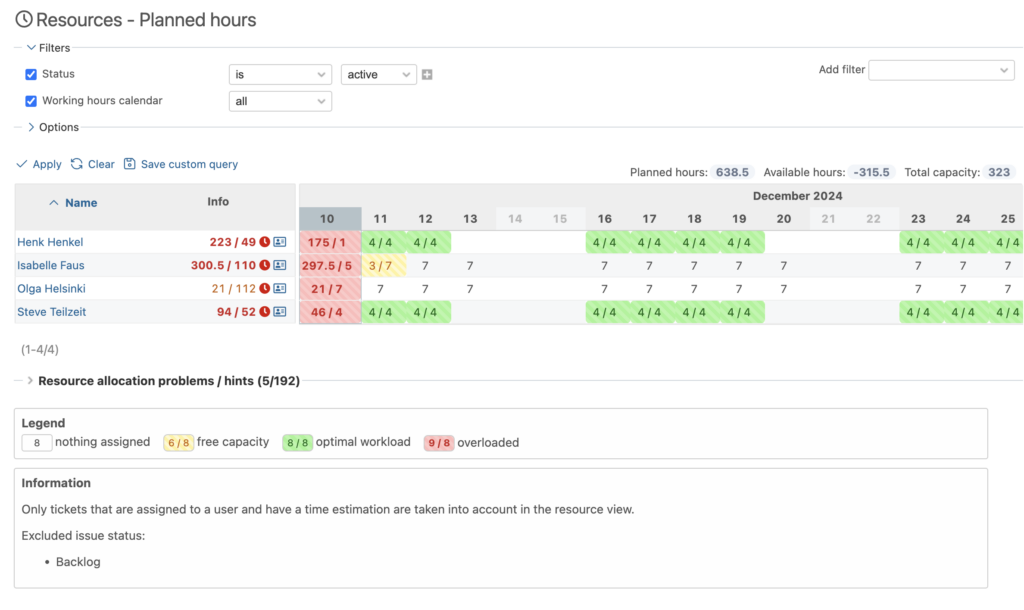
Collaboration and communication tools
Redmine offers a number of features that help teams work together more efficiently.
Its built-in document management system lets you store and share project files, be it technical documentation or project plans. When managing documents, here’s what you can do:
- Upload and organize files by project
- Track document versions and changes
- Control who can view and edit files
- Add descriptions and category tags
- Search through stored documents
You can also create project wikis – a shared knowledge base where team members can document key processes, guidelines, and other important information related to a project.
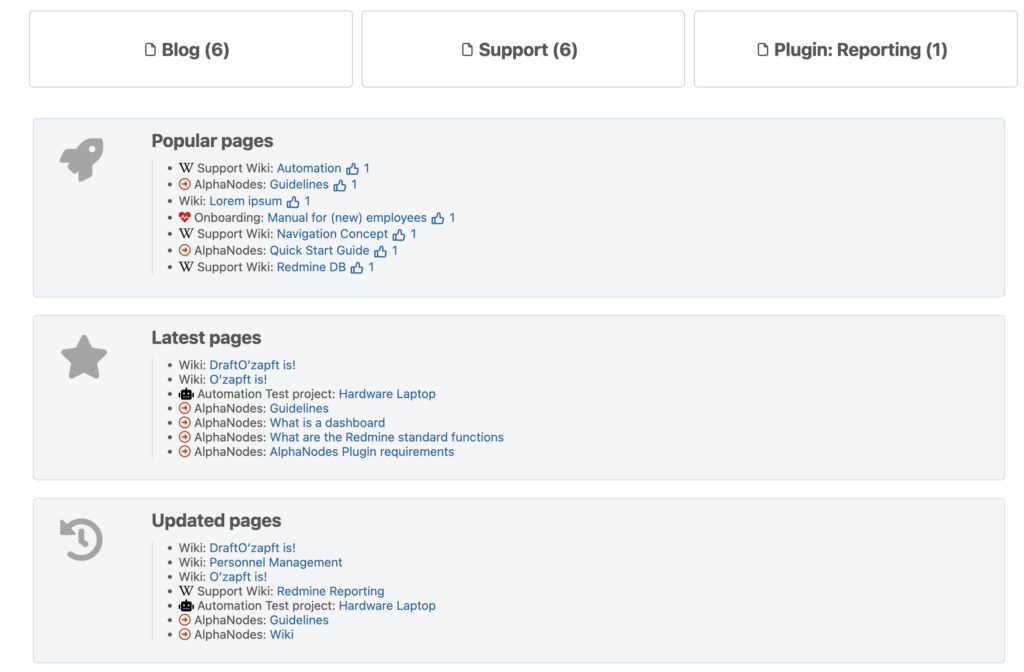
Finally, Redmine connects with popular version control systems like Git, SVN, and Mercurial, which is especially useful for developers. We will expand on this more in a later section.
User and role management
With all the information in Redmine, it’s important to control who can access what using roles and permissions.
Project managers can create custom roles that match their team’s structure and assign different levels of access. For example, some team members only need to view tasks, while others require full editing rights across multiple projects.
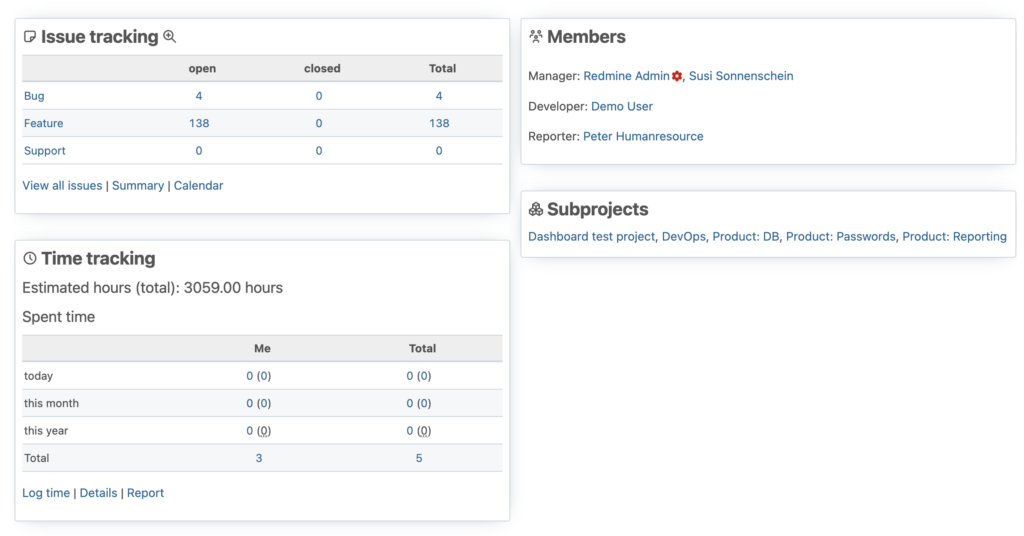
When managing user roles in Redmine, you can:
- Control who can create, edit, and delete items
- Assign multiple roles to one user
- Adjust view and edit permissions for wikis and documents
- Manage access to version control repositories
- Set up issue tracking permissions by role
Since managing many user accounts can get complex, Redmine also connects with LDAP authentication systems. This means teams can use their existing company credentials to log in, so there’s no need for separate Redmine accounts.
Customizable reports
Redmine can turn the information from your tasks, time logs, and project activities into detailed reports that show how your team is progressing. This helps spot the processes that are working well and areas for improvement.
When creating reports in Redmine, you can:
- Filter data by project, user, or time period
- Group information by categories
- Sort results by priority, status, or dates
- Export data to different formats
- Save report settings for quick access
- Create custom report templates
- Share reports with team members
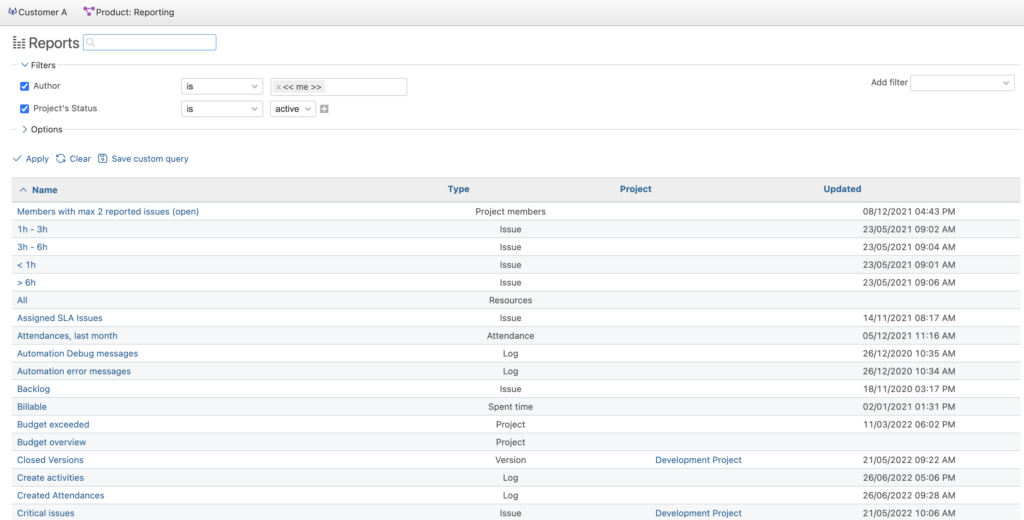
Redmine also lets you create tailored reports using sophisticated filtering and grouping capabilities. You can use various plugins and extensions to combine data from multiple sources, such as issues, time entries, and custom fields, into comprehensive reports.
For example, you might generate a report showing time spent across project categories, grouped by user and filtered by specific custom fields like task type or priority level.
Customization and integration options
The best part about Redmine? It lets you add more functionalities beyond what comes with the standard built-in features. Since it’s open source, you can customize Redmine in several ways.
- Add plugins for new features
- Modify its appearance with themes
- Integrate with version control systems
- Connect it to other third-party tools
Let’s look at each of them in detail.
Plugins and extensions
Plugins are additional pieces of software that add new features to Redmine. You’ll find over 1,000 plugins in the official Redmine plugin directory and third-party sources like RedmineUP.
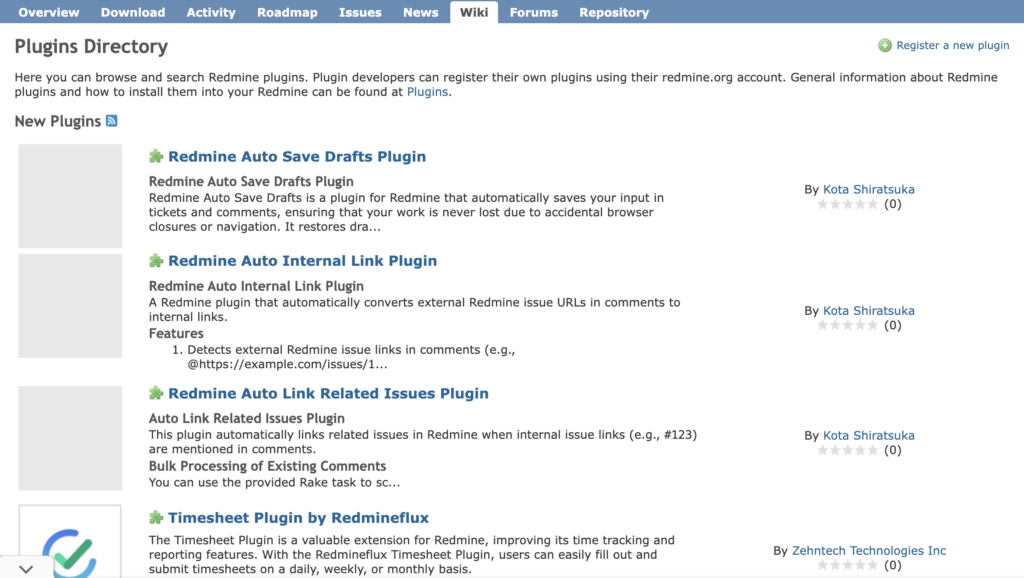
Here are some features you can add through plugins:
- Extended custom field options
- Automation tools for repetitive work
- Advanced reporting and analytics
- DevOps features for GitHub and GitLab integration
- Digital asset management tools
- Resource planning and HRM features
- Time tracking enhancements
While many Redmine plugins are free, premium options offer more advanced features for specific needs. For instance, Redmine Helpdesk adds an advanced support system:
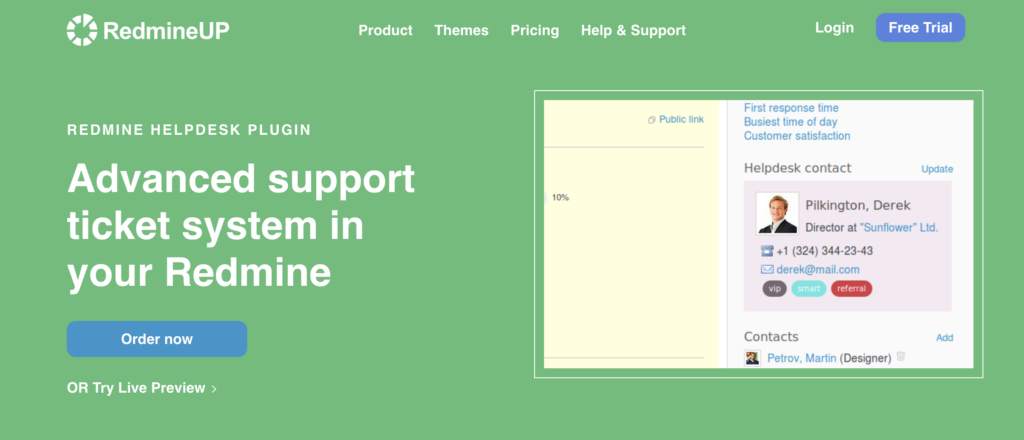
To install a plugin, you need to copy the plugin files to your Redmine plugin directory, install additional Ruby libraries (called gems), update the database, and restart Redmine.
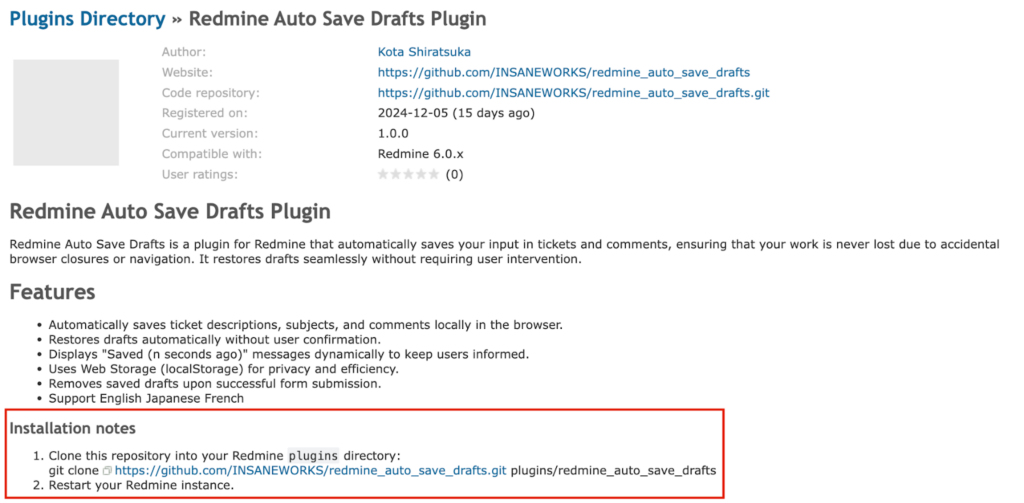
Once set up, the plugins should integrate with Redmine’s core features and work together as one system.
Themes and user interface
Redmine’s customizability also extends to its appearance. You can use themes to make Redmine more visually appealing and easier to navigate. Many offer modern layouts, mobile-friendly designs, and intuitive navigation.
Here are some popular Redmine themes:
- PurpleMine2: A sleek theme that simplifies navigation and looks great on any screen size.
- minimalflat2: A clean, minimalist option with subtle colors and clear layouts.
- A1 Theme: A responsive, flat design compatible with many Redmine versions.
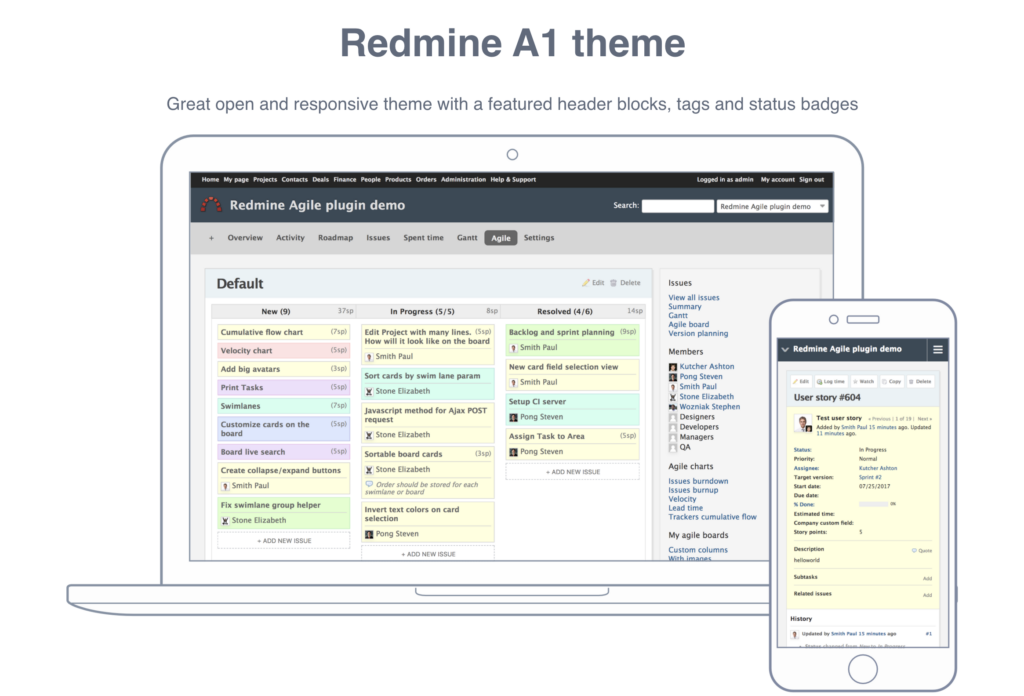
Similar to plugins, you can find lots of themes in the official Redmine theme directory. Most themes are created by the Redmine community and are available for free. That said, there are many premium options, like Redmine UX Upgrade:
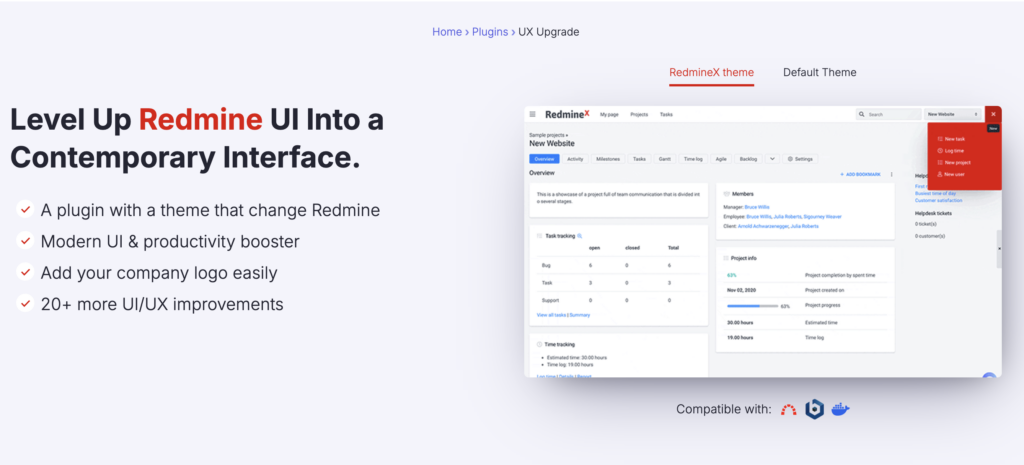
Version control system integration
For developers, Redmine offers integrated connections to code repositories. This means your Git, SVN, or Mercurial repositories can link directly to Redmine, making the development process more efficient.
With these integrations, developers can browse commit history and file changes right in Redmine’s interface, with each code update automatically linking to its related task. So, when someone looks at a task, they can immediately see what changes were made to the code.
You can also connect multiple repositories to a single project and control the access by using Redmine’s permissions. This means different teams in your company can work on different parts of the code while still being able to see how everything fits together.
Other third-party tools integration
Besides version control, Redmine can connect with dozens of development, testing, and project management tools. For example, you can track quality assurance through the TestRail integration, manage tasks via mobile apps, or streamline workflows with browser extensions.
For custom integration needs, Redmine provides a REST API. Developers can use it to create, read, update, and delete issues and other data programmatically.
Benefits of using Redmine
Now that you’ve learned more about Redmine, let’s sum up the reasons why it could be the best choice for your team.
Open source and cost-effective
Redmine’s open-source nature brings two main advantages.
First, it’s free to use. So, a team of any size can use it without having to spend thousands of dollars on software licenses like they would with commercial tools.
Second, being open source means you’re not locked into one ecosystem. You can add custom reports, modify issue tracking, and customize any other piece of Redmine’s code.
Community support and documentation
The free version of Redmine doesn’t offer professional support. However, numerous resources are available to help you solve issues quickly.
The official documentation includes detailed guides, FAQs, and step-by-step tutorials. That said, what makes Redmine truly special is its active community. Redmine users help each other directly in forums and IRC chatrooms, as well as through community-written tutorials.
When someone in the community has already solved the problem you’re experiencing, existing resources can provide a faster solution than paid support channels.
Scalability and flexibility
Finally, Redmine grows with your organization. Small teams can start with basic issue tracking and gradually add more features. Larger organizations can run multiple complex projects with hundreds of users.
It’s also flexible in its use cases:
- Software teams can track bugs and feature development
- Marketing departments can manage campaigns and content calendars
- Client service teams can handle support tickets
- HR departments can manage internal requests
You can easily handle growth using specialized Redmine hosting providers.
At Hostinger, we offer Redmine VPS hosting that scales with your needs, with features like automatic backups, malware scanning, and high-speed storage. As your team expands and projects become more complex, you can quickly upgrade server resources without disrupting your workflow.

Conclusion
Redmine offers essential tools for your team to manage projects effectively. Its built-in features and endless customization options make it a great option for teams with complex workflows and highly specific needs.
Redmine can be the perfect project management software for you if you:
- Want full control over your project management setup
- Need to customize workflows and features
- Don’t want to spend a lot of money on expensive licenses
- Are tech-savvy, or have a tech staff who can handle its setup and maintenance
Ready to give Redmine a try? Check out our Redmine tutorial and get started right away.
What is Redmine FAQ
How does Redmine work?
Redmine is a web application built on Ruby on Rails. It runs on a web server (through a hosting provider or your own), and its interface can be accessed through a web browser. All project data is stored in a database (MySQL or PostgreSQL), while files and documents are kept on the server.
What is Redmine used for?
You can use Redmine for all kinds of teamwork, such as assigning projects and subprojects, reporting bugs, following up on fixes, tracking time spent on tasks, and sharing documents.
Is Redmine similar to Jira?
Both are project management tools, but they have key differences. Jira is a paid tool with a modern interface and features for agile teams, while Redmine gives you more freedom to customize everything but requires more resources to deploy. For more information, check out our Jira vs Redmine comparison.
Is Redmine free?
Redmine is completely free. You can download it, modify it, and use it without paying any licensing fees.


